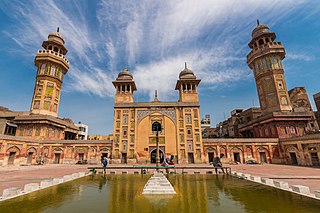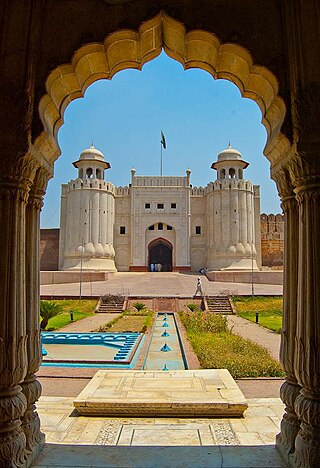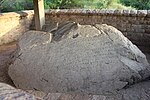
The Lahore Fort is a citadel in the city of Lahore in Punjab, Pakistan. The fortress is located at the northern end of Walled city of Lahore and spreads over an area greater than 20 hectares. It contains 21 notable monuments, some of which date to the era of Emperor Akbar. The Lahore Fort is notable for having been almost entirely rebuilt in the 17th century, when the Mughal Empire was at the height of its splendor and opulence.

The Wazir Khan Mosque is a 17th-century mosque located in the city of Lahore, Punjab, Pakistan. The mosque was commissioned during the reign of the Mughal Emperor Shah Jahan as a part of an ensemble of buildings that also included the nearby Shahi Hammam baths. Construction of Wazir Khan Mosque began in 1634 C.E., and was completed in 1641. It is on the UNESCO World Heritage Tentative List.

Mughal architecture is the type of Indo-Islamic architecture developed by the Mughals in the 16th, 17th and 18th centuries throughout the ever-changing extent of their empire in the Indian subcontinent. It developed from the architectural styles of earlier Muslim dynasties in India and from Iranian and Central Asian architectural traditions, particularly Timurid architecture. It also further incorporated and syncretized influences from wider Indian architecture, especially during the reign of Akbar. Mughal buildings have a uniform pattern of structure and character, including large bulbous domes, slender minarets at the corners, massive halls, large vaulted gateways, and delicate ornamentation; examples of the style can be found in modern-day Afghanistan, Bangladesh, India and Pakistan.
The Aga Khan Trust for Culture (AKTC) is an agency of the Aga Khan Development Network (AKDN), a family of institutions created by Aga Khan IV with distinct but complementary mandates to improve the welfare and prospects of people in the developing world, particularly in Asia and Africa. It focuses on the revitalization of communities in the Muslim world—physical, social, cultural, and economic. The AKTC was founded in 1988 and is registered in Geneva, Switzerland, as a private non-denominational philanthropic foundation.

Tourism in Pakistan is a growing industry. In 2010, Lonely Planet termed Pakistan "tourism's 'next big thing'". The country is geographically and ethnically diverse, and has a number of historical and cultural heritage sites. Condé Nast Traveller ranked Pakistan The Best Holiday Destination for 2020 and also declared it the third-highest potential adventure destination in the world for 2020. As security in the country improves, tourism increases; in two years, it has increased by more than 300%. The Pakistani government had launched online visa services for 175 countries and 50 countries were offered visa on arrival, making visiting Pakistan easier. The country received an influx of travel vloggers, who promoted the characteristics of the country, such as in the Northern Pakistan, like Hunza and Skardu.
Pakistani architecture is intertwined with the architecture of the broader Indian subcontinent. The major architectural styles popular in the past were Temple, Indo-Islamic, Mughal and Indo-Saracenic architecture, all of which have many regional varieties. With the beginning of the Indus civilization around the middle of the 3rd millennium BC, for the first time in the area which encompasses today's Pakistan an advanced urban culture developed with large structural facilities, some of which survive to this day. This was followed by the Gandhara style of Buddhist architecture that borrowed elements from Ancient Greece. These remnants are visible in the Gandhara capital of Taxila.
Pakistan's cultural heritage includes archaeological sites, stupas, forts, shrines, tombs, buildings, residences, monuments, and places of worship. Until the passing of the Eighteenth Amendment to the Constitution of Pakistan, some sites were under the federal government while others were in the provincial domain.




































